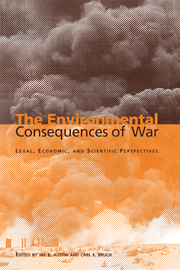Book contents
- Frontmatter
- Contents
- List of illustrations
- List of tables
- List of contributors
- Acknowledgements
- Foreword by Klaus Toepfer
- Introduction
- Part I General principles
- Part II The legal framework
- Part III Assessing the impacts – scientific methods and issues
- Introduction
- 11 Scientific assessment of the long-term environmental consequences of war
- 12 The Gulf War impact on the terrestrial environment of Kuwait: an overview
- 13 War-related damage to the marine environment in the ROPME Sea Area
- 14 War and biodiversity: an assessment of impacts
- Introduction
- 15 Tracking the four horsemen: the public health approach to the impact of war and war-induced environmental destruction in the twentieth century
- 16 Defoliants: the long-term health implications
- 17 The impact of military preparedness and militarism on health and the environment
- 18 War and infectious diseases: international law and the public health consequences of armed conflict
- Part IV Valuing the impacts – economic methods and issues
- Part V Prospects for the future
- Index
Introduction
Published online by Cambridge University Press: 04 August 2010
- Frontmatter
- Contents
- List of illustrations
- List of tables
- List of contributors
- Acknowledgements
- Foreword by Klaus Toepfer
- Introduction
- Part I General principles
- Part II The legal framework
- Part III Assessing the impacts – scientific methods and issues
- Introduction
- 11 Scientific assessment of the long-term environmental consequences of war
- 12 The Gulf War impact on the terrestrial environment of Kuwait: an overview
- 13 War-related damage to the marine environment in the ROPME Sea Area
- 14 War and biodiversity: an assessment of impacts
- Introduction
- 15 Tracking the four horsemen: the public health approach to the impact of war and war-induced environmental destruction in the twentieth century
- 16 Defoliants: the long-term health implications
- 17 The impact of military preparedness and militarism on health and the environment
- 18 War and infectious diseases: international law and the public health consequences of armed conflict
- Part IV Valuing the impacts – economic methods and issues
- Part V Prospects for the future
- Index
Summary
The public health impacts of war often directly correspond to the various ecological consequences described in the previous section. The use of conventional weapons results in impacts such as pollution, depletion of resources, and destruction of vital health-related infrastructure, and frequently causes severe collateral damage to civilian health. In addition, the production, testing, use, and even dismantling of weapons of mass destruction can release deadly toxins with widespread health effects.
Many of the same methodological constraints and scientific uncertainties that impede accurate prediction and assessment of ecological impacts also plague the process of determining the causes and extent of public health damage during war. The nature of the public health discipline also presents unique challenges to achieving accurate assessment and creating successful intervention strategies. The authors in this section address both the health impacts themselves, and reasons and possible solutions for these methodological difficulties.
Jennifer Leaning examines the discipline of public health itself, tracing the history of its relationship with violent conflict, including the more recent, specifically public-health-related challenges presented by many of the conflicts that have taken place since the Cold War. Alastair Hay focuses on the health-related impacts of the use of defoliants during the Vietnam War. Victor Sidel calls attention to the types of environmental and public health damage that result from preparations for war, and broadens the scope of inquiry through an assessment of the ramifications of “militarism” viewed broadly. Finally, David Fidler focuses on the alterations of the humanmicrobe relationship that result from wartime conditions as the basis forexploring the international legal framework for preventing and mitigating morbidity and mortality in wartime.
- Type
- Chapter
- Information
- The Environmental Consequences of WarLegal, Economic, and Scientific Perspectives, pp. 379 - 383Publisher: Cambridge University PressPrint publication year: 2000



